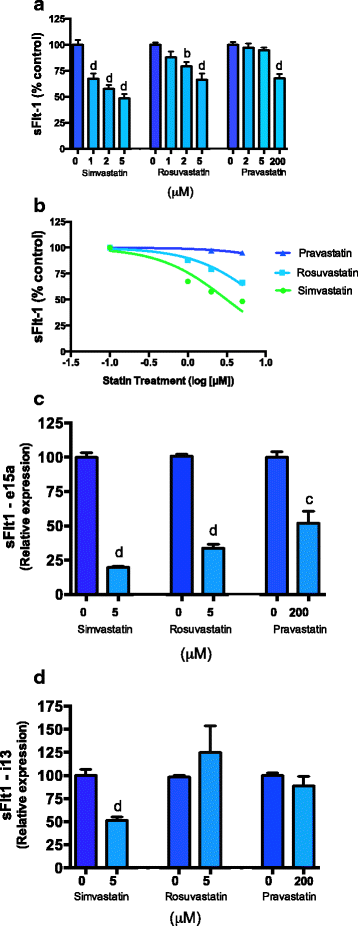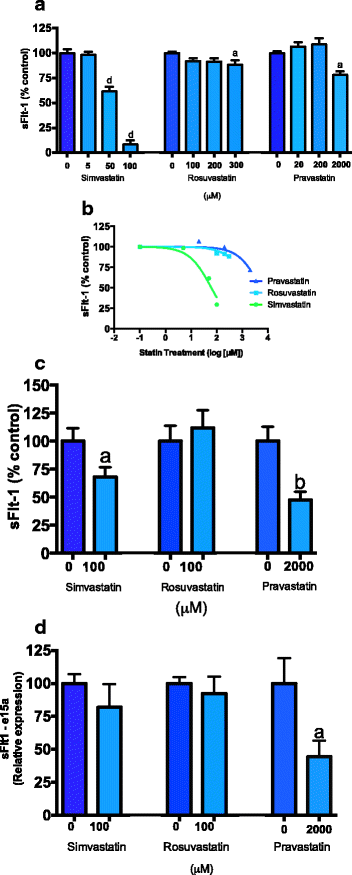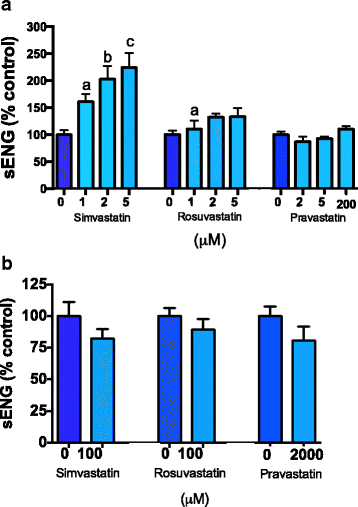Effects of simvastatin, rosuvastatin and pravastatin on soluble fms-like tyrosine kinase 1 (sFlt-1) and soluble endoglin (sENG) secretion from human umbilical vein endothelial cells, primary trophoblast cells and placenta
- PMID: 27207105
- PMCID: PMC4874016
- DOI: 10.1186/s12884-016-0902-3
Effects of simvastatin, rosuvastatin and pravastatin on soluble fms-like tyrosine kinase 1 (sFlt-1) and soluble endoglin (sENG) secretion from human umbilical vein endothelial cells, primary trophoblast cells and placenta
Abstract
Background: Preeclampsia is associated with the placental release of soluble fms-like tyrosine kinase 1 (sFlt-1) and soluble endoglin (sENG). These anti-angiogenic factors cause hypertension and multi-organ injury. Pravastatin decreases placental secretion of sFlt-1 in vitro and is currently being examined in clinical trials as a potential treatment for preeclampsia. However, it is possible that different classes of statins may be more potent at decreasing sFlt-1 secretion. We compared the relative potency of three different generations of statins on sFlt-1 and sENG secretion from human endothelial cells, trophoblast cells, and placenta explants.
Methods: We performed functional experiments using primary human umbilical vein endothelial cells, trophoblast cells and preterm preeclamptic placental explants to assess the affect of simvastatin, rosuvastatin and pravastatin on sFlt-1 and sENG secretion and compared the relative potency of each statin at reducing these factors (Inhibitory Concentration 50). Furthermore we assessed the effect of each statin on the antioxidant and cytoprotective enzyme, heme-oxygenase 1.
Results: All statins reduced sFlt-1 secretion from endothelial cells, trophoblasts and preterm preeclamptic placental explants. Simvastatin was the most potent inhibitor of sFlt-1 secretion from endothelial cells (IC 50 3.2 μM), trophoblast cells (IC 50 61.4 μM) and placental explants. Simvastatin was 28 times and 3 times more potent at reducing sFlt-1 secretion from endothelial cells and 85 times and 33 times more potent at reducing sFlt-1 secretion from trophoblast cells than pravastatin or rosuvastatin respectively. All statins increased sENG secretion from endothelial cells however did not change secretion from placental explants. While all statins up-regulated heme-oxygenase 1 in endothelial cells, only simvastatin up-regulated its expression in placenta from patients with preterm preeclampsia.
Conclusion: Simvastatin may be a more potent inhibitor of sFlt-1 secretion from endothelial cells, trophoblast cells and placenta from women with preterm preeclampsia than either pravastatin or rosuvastatin.
Keywords: Preeclampsia; Pregnancy; Soluble endoglin; Statins; sFlt-1.
Figures




Similar articles
-
Heme Oxygenase-1 Is Not Decreased in Preeclamptic Placenta and Does Not Negatively Regulate Placental Soluble fms-Like Tyrosine Kinase-1 or Soluble Endoglin Secretion.Hypertension. 2015 Nov;66(5):1073-81. doi: 10.1161/HYPERTENSIONAHA.115.05847. Epub 2015 Aug 31. Hypertension. 2015. PMID: 26324507
-
Soluble endoglin production is upregulated by oxysterols but not quenched by pravastatin in primary placental and endothelial cells.Placenta. 2014 Sep;35(9):724-31. doi: 10.1016/j.placenta.2014.06.374. Epub 2014 Jul 5. Placenta. 2014. PMID: 25043692
-
Melatonin enhances antioxidant molecules in the placenta, reduces secretion of soluble fms-like tyrosine kinase 1 (sFLT) from primary trophoblast but does not rescue endothelial dysfunction: An evaluation of its potential to treat preeclampsia.PLoS One. 2018 Apr 11;13(4):e0187082. doi: 10.1371/journal.pone.0187082. eCollection 2018. PLoS One. 2018. PMID: 29641523 Free PMC article.
-
Therapeutic potential of statins and the induction of heme oxygenase-1 in preeclampsia.J Reprod Immunol. 2014 Mar;101-102(100):153-160. doi: 10.1016/j.jri.2013.12.120. Epub 2014 Jan 16. J Reprod Immunol. 2014. PMID: 24503248 Free PMC article. Review.
-
Effects of statins on preeclampsia: A systematic review.Pregnancy Hypertens. 2021 Mar;23:123-130. doi: 10.1016/j.preghy.2020.11.014. Epub 2020 Dec 11. Pregnancy Hypertens. 2021. PMID: 33333432
Cited by
-
Esomeprazole inhibits hypoxia/endothelial dysfunction-induced autophagy in preeclampsia.Cell Tissue Res. 2022 Apr;388(1):181-194. doi: 10.1007/s00441-022-03587-z. Epub 2022 Jan 29. Cell Tissue Res. 2022. PMID: 35091806 Free PMC article.
-
Current Approaches and Innovations in Managing Preeclampsia: Highlighting Maternal Health Disparities.J Clin Med. 2025 Feb 11;14(4):1190. doi: 10.3390/jcm14041190. J Clin Med. 2025. PMID: 40004721 Free PMC article. Review.
-
Pregnancy Outcome in Women with Obstetric and Thrombotic Antiphospholipid Syndrome-A Retrospective Analysis and a Review of Additional Treatment in Pregnancy.Clin Rev Allergy Immunol. 2017 Aug;53(1):54-67. doi: 10.1007/s12016-016-8569-0. Clin Rev Allergy Immunol. 2017. PMID: 27395067
-
Pravastatin in preeclampsia: A meta-analysis and systematic review.Front Med (Lausanne). 2023 Jan 13;9:1076372. doi: 10.3389/fmed.2022.1076372. eCollection 2022. Front Med (Lausanne). 2023. PMID: 36714131 Free PMC article.
-
Sulfasalazine reduces placental secretion of antiangiogenic factors, up-regulates the secretion of placental growth factor and rescues endothelial dysfunction.EBioMedicine. 2019 Mar;41:636-648. doi: 10.1016/j.ebiom.2019.02.013. Epub 2019 Feb 26. EBioMedicine. 2019. PMID: 30824385 Free PMC article.
References
-
- Maynard S, Min JY, Merchan J, Lim KH, Li J, Mondal S, Libermann TA, Morgan JP, Sellke FW, Stillman IE, Epstein FH, Sukhatme VP, Ananth Karumanchi S. Excess placental soluble fms-like tyrosine kinase 1 (sFlt-1) may contribute to endothelial dysfunction, hypertension, and proteinuria in pre-eclampsia. J Clin Invest. 2003;111(5):649–658. doi: 10.1172/JCI17189. - DOI - PMC - PubMed
MeSH terms
Substances
LinkOut - more resources
Full Text Sources
Other Literature Sources
Medical
Miscellaneous

